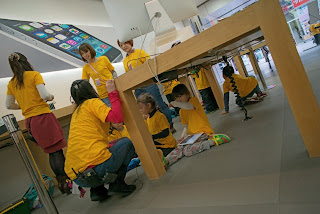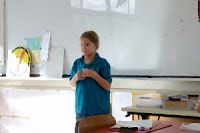This was a great chance for my students to get out of the classroom, and hear a different voice from my own.
We went downtown and walked to the Apple Store. We arrived before they had opened to the public and the staff was waiting at the door to welcome the students as V.I.P.s.
I headed to the back of the store -- expecting to find a room there where the students could go and be out of the limelight of the now gazing customers.
I was wrong.
The staff had roped off a section in the middle of the store for us to use.
I will stop the story here and ask: Have you ever tried to talk to a kid with an iPad in front of him/her? Now imagine kids in the middle of the actual Apple Store and asked to listen.
No, it didn't work.
Not only were they distracted by the gadgets all around, but there were customers and music was playing the whole time as well.
But, then the instructor told them they had 30 minutes to go outside the store and take pictures and videos. The students ran outside and it was all I could do to stay in front of them and prevent them from not going too far.
Once they settled down though, they got really into taking pictures and videos. This was a great advertisement for Apple as well because passers by would comment on how young children were able to independently use the iPads. And, it is Christmas season and the new generation of iPads just came out. (Was this planned?)
When the students went back inside, it was time for them to put their movies together. The instructor explained how to do it, but many of the students could not or did not hear what was said. Despite that, they sat there, on the floor of the Apple Store for about 30 minutes putting everything together.
The students even got to keep their yellow t-shirts and also got a certificate of completion and a USB bracelet.
Flip the Trip
Right now in my COETAIL course we are looking at Flipped Instruction. As I reflected on the experience I thought how great it would be for Apple to flip the field trip.In my thank you letter to them, I wrote:
I suggest when you have students come in, they watch a preloaded video of how to use the app you are teaching on their iPads. That way the students could rewind the video when they do not understand/hear the instructions.
Thinking about it now, they could make a video they put on YouTube. We watch it at school and start the movies. Then on the field trip, we go to the Apple Store and finish putting them together. Then finally show them there (in the middle of the store).
Students could still go out into the street and take video [or act as an Apple billboard].





















.jpg)







